Uptake of BF Dye from the Aqueous Phase by CaO-g-C3N4 Nanosorbent: Construction, Descriptions, and Recyclability
Abstract
:1. Introduction
2. Experimental
2.1. Chemicals
2.2. CaO-g-C3N4 Nanosorbent Fabrication
2.3. CaO-g-C3N4 Nanosorbent Characterizations
2.4. BF Dye Removal Experiments
3. Results and Discussion
3.1. CaO-g-C3N4 Nanosorbent Characterizations
3.2. BF Removal onto CaO-g-C3N4 Nanosorbent
3.2.1. Impact of Variation pH on BF Removal by CaO-g-C3N4 Nanosorbent
3.2.2. Influence of the Initial BF Dye Concentration and Doping
3.2.3. Adsorption Equilibrium of BF Dyes onto CaO-C3N4 Nanosorbent
3.2.4. BF Contact Time and Adsorption Kinetic Studies
3.3. Regeneration and Reusability Study
3.4. Comparison Study
3.5. Adsorption Mechanism
4. Conclusions
Author Contributions
Funding
Acknowledgments
Conflicts of Interest
References
- Zamora-Ledezma, C.; Negrete-Bolagay, D.; Figueroa, F.; Zamora-Ledezma, E.; Ni, M.; Alexis, F.; Guerrero, V.H. Heavy metal water pollution: A fresh look about hazards, novel and conventional remediation methods. Environ. Technol. Innov. 2021, 22, 101504. [Google Scholar] [CrossRef]
- Brown, D. Effects of colorants in the aquatic environment. Ecotoxicol. Environ. Saf. 1987, 13, 139–147. [Google Scholar] [CrossRef] [PubMed]
- Hasan, Z.; Jhung, S.H. Removal of hazardous organics from water using metal-organic frameworks (MOFs): Plausible mechanisms for selective adsorptions. J. Hazard. Mater. 2015, 283, 329–339. [Google Scholar] [CrossRef]
- Zeitoun, M.M.; Mehana, E. Impact of water pollution with heavy metals on fish health: Overview and updates. Glob. Vet. 2014, 12, 219–231. [Google Scholar]
- La Farre, M.; Pérez, S.; Kantiani, L.; Barceló, D. Fate and toxicity of emerging pollutants, their metabolites and transformation products in the aquatic environment. TrAC Trends Anal. Chem. 2008, 27, 991–1007. [Google Scholar] [CrossRef]
- Thakur, R.H.; Fung, D. Effect of Dyes on the Growth of Food MOLDS 1. J. Rapid Methods Autom. Microbiol. 1995, 4, 1–35. [Google Scholar] [CrossRef]
- Mirzaei, F.; Nilash, M.M.; Fakhari, A.R. Development of a new electromembrane extraction combined with ion mobility spectrometry for the quantification of malachite green in water samples. Int. J. Ion Mobil. Spectrom. 2020, 23, 153–160. [Google Scholar] [CrossRef]
- Rajumon, R.; Anand, J.C.; Ealias, A.M.; Desai, D.S.; George, G.; Saravanakumar, M. Adsorption of textile dyes with ultrasonic assistance using green reduced graphene oxide: An in-depth investigation on sonochemical factors. J. Environ. Chem. Eng. 2019, 7, 103479. [Google Scholar] [CrossRef]
- Ritter, C. Studies of the toxicity of basic fuchsin for certain bacteria. Am. J. Public Health Nations Health 1940, 30, 59–65. [Google Scholar] [CrossRef]
- Fernandes, E.P.; Silva, T.S.; Carvalho, C.M.; Selvasembian, R.; Chaukura, N.; Oliveira, L.M.; Meneghetti, S.M.P.; Meili, L. Efficient adsorption of dyes by γ-alumina synthesized from aluminum wastes: Kinetics, isotherms, thermodynamics and toxicity assessment. J. Environ. Chem. Eng. 2021, 9, 106198. [Google Scholar] [CrossRef]
- Casas, N.; Parella, T.; Vicent, T.; Caminal, G.; Sarrà, M. Metabolites from the biodegradation of triphenylmethane dyes by Trametes versicolor or laccase. Chemosphere 2009, 75, 1344–1349. [Google Scholar] [CrossRef] [PubMed]
- Moumen, A.; Belhocine, Y.; Sbei, N.; Rahali, S.; Ali, F.A.M.; Mechati, F.; Hamdaoui, F.; Seydou, M. Removal of Malachite Green Dye from Aqueous Solution by Catalytic Wet Oxidation Technique Using Ni/Kaolin as Catalyst. Molecules 2022, 27, 7528. [Google Scholar] [CrossRef] [PubMed]
- Adam, F.A.; Ghoniem, M.; Diawara, M.; Rahali, S.; Abdulkhair, B.Y.; Elamin, M.; Aissa, M.A.B.; Seydou, M. Enhanced adsorptive removal of indigo carmine dye by bismuth oxide doped MgO based adsorbents from aqueous solution: Equilibrium, kinetic and computational studies. RSC Adv. 2022, 12, 24786–24803. [Google Scholar] [CrossRef]
- Attia, G.; Rahali, S.; Teka, S.; Fourati, N.; Zerrouki, C.; Seydou, M.; Chehimi, S.; Hayouni, S.; Mbakidi, J.-P.; Bouquillon, S. Anthracene based surface acoustic wave sensors for picomolar detection of lead ions. Correlation between experimental results and DFT calculations. Sens. Actuators B Chem. 2018, 276, 349–355. [Google Scholar] [CrossRef]
- Pandey, S.; Son, N.; Kim, S.; Balakrishnan, D.; Kang, M. Locust Bean gum-based hydrogels embedded magnetic iron oxide nanoparticles nanocomposite: Advanced materials for environmental and energy applications. Environ. Res. 2022, 214, 114000. [Google Scholar] [CrossRef]
- Doondani, P.; Jugade, R.; Gomase, V.; Shekhawat, A.; Bambal, A.; Pandey, S. Chitosan/Graphite/Polyvinyl Alcohol Magnetic Hydrogel Microspheres for Decontamination of Reactive Orange 16 Dye. Water 2022, 14, 3411. [Google Scholar] [CrossRef]
- Gomase, V.; Jugade, R.; Doondani, P.; Deshmukh, S.; Saravanan, D.; Pandey, S. Dual modifications of chitosan with PLK for amputation of cyanide ions: Equilibrium studies and optimization using RSM. Int. J. Biol. Macromol. 2022, 223, 636–651. [Google Scholar] [CrossRef]
- Rahali, S.; Ben Aissa, M.A.; Khezami, L.; Elamin, N.; Seydou, M.; Modwi, A. Adsorption behavior of Congo red onto barium-doped ZnO nanoparticles: Correlation between experimental results and DFT calculations. Langmuir 2021, 37, 7285–7294. [Google Scholar] [CrossRef]
- Wu, Y.; Zuo, F.; Zheng, Z.; Ding, X.; Peng, Y. A novel approach to molecular recognition surface of magnetic nanoparticles based on host–guest effect. Nanoscale Res. Lett. 2009, 4, 738–747. [Google Scholar] [CrossRef] [Green Version]
- Khezami, L.; Aissa, M.A.B.; Modwi, A.; Guesmi, A.; Algethami, F.K.; Bououdina, M. Efficient removal of organic dyes by Cr-doped ZnO nanoparticles. Biomass Convers. Biorefin. 2022, 1–14. [Google Scholar] [CrossRef]
- Khezami, L.; Aissa, M.A.B.; Modwi, A.; Ismail, M.; Guesmi, A.; Algethami, F.K.; Ticha, M.B.; Assadi, A.A.; Nguyen-Tri, P. Harmonizing the photocatalytic activity of g-C3N4 nanosheets by ZrO2 stuffing: From fabrication to experimental study for the wastewater treatment. Biochem. Eng. J. 2022, 182, 108411. [Google Scholar] [CrossRef]
- Aldaghri, O.; Modwi, A.; Idriss, H.; Ali, M.; Ibnaouf, K. Cleanup of Cd II from water media using Y2O3@ gC3N4 (YGCN) nanocomposite. Diam. Relat. Mater. 2022, 129, 109315. [Google Scholar] [CrossRef]
- Modwi, A.; Elamin, M.R.; Idriss, H.; Elamin, N.Y.; Adam, F.A.; Albadri, A.E.; Abdulkhair, B.Y. Excellent Adsorption of Dyes via MgTiO3@ g-C3N4 Nanohybrid: Construction, Description and Adsorption Mechanism. Inorganics 2022, 10, 210. [Google Scholar] [CrossRef]
- Modwi, A.; Basith, N.; Ghoniem, M.; Ismail, M.; Aissa, M.B.; Khezami, L.; Bououdina, M. Efficient Pb (II) adsorption in aqueous solution by hierarchical 3D/2D TiO2/CNNS nanocomposite. Mater. Sci. Eng. B 2023, 289, 116191. [Google Scholar] [CrossRef]
- Toghan, A.; Abd El-Lateef, H.M.; Taha, K.K.; Modwi, A. Mesoporous TiO2@ g-C3N4 composite: Construction, characterization, and boosting indigo carmine dye destruction. Diam. Relat. Mater. 2021, 118, 108491. [Google Scholar] [CrossRef]
- Qamar, M.A.; Shahid, S.; Javed, M.; Iqbal, S.; Sher, M.; Akbar, M.B. Highly efficient g-C3N4/Cr-ZnO nanocomposites with superior photocatalytic and antibacterial activity. J. Photochem. Photobiol. A Chem. 2020, 401, 112776. [Google Scholar] [CrossRef]
- Gogoi, D.; Makkar, P.; Ghosh, N.N. Solar light-irradiated photocatalytic degradation of model dyes and industrial dyes by a magnetic CoFe2O4–gC3N4 S-scheme heterojunction photocatalyst. ACS Omega 2021, 6, 4831–4841. [Google Scholar] [CrossRef]
- Varapragasam, S.J.; Andriolo, J.M.; Skinner, J.L.; Grumstrup, E.M. Photocatalytic Reduction of Aqueous Nitrate with Hybrid Ag/g-C3N4 under Ultraviolet and Visible Light. ACS Omega 2021, 6, 34850–34856. [Google Scholar] [CrossRef]
- Cai, W.; Tang, J.; Shi, Y.; Wang, H.; Jiang, X. Improved in situ synthesis of heterostructured 2D/2D BiOCl/g-C3N4 with enhanced dye photodegradation under visible-light illumination. ACS Omega 2019, 4, 22187–22196. [Google Scholar] [CrossRef] [Green Version]
- Alhaddad, M.; Mohamed, R.M.; Mahmoud, M.H. Promoting Visible Light Generation of Hydrogen Using a Sol–Gel-Prepared MnCo2O4@ g-C3N4 p–n Heterojunction Photocatalyst. ACS Omega 2021, 6, 8717–8725. [Google Scholar] [CrossRef]
- Paul, D.R.; Gautam, S.; Panchal, P.; Nehra, S.P.; Choudhary, P.; Sharma, A. ZnO-modified g-C3N4: A potential photocatalyst for environmental application. ACS Omega 2020, 5, 3828–3838. [Google Scholar] [CrossRef] [PubMed]
- Li, Y.; Wang, J.; Yang, Y.; Zhang, Y.; He, D.; An, Q.; Cao, G. Seed-induced growing various TiO2 nanostructures on g-C3N4 nanosheets with much enhanced photocatalytic activity under visible light. J. Hazard. Mater. 2015, 292, 79–89. [Google Scholar] [CrossRef] [PubMed]
- Ngullie, R.C.; Alaswad, S.O.; Bhuvaneswari, K.; Shanmugam, P.; Pazhanivel, T.; Arunachalam, P. Synthesis and Characterization of Efficient ZnO/g-C3N4 Nanocomposites Photocatalyst for Photocatalytic Degradation of Methylene Blue. Coatings 2020, 10, 500. [Google Scholar] [CrossRef]
- Madhu, B.; Bhagyalakshmi, H.; Shruthi, B.; Veerabhadraswamy, M. Structural, AC conductivity, dielectric and catalytic behavior of calcium oxide nanoparticles derived from waste eggshells. SN Appl. Sci. 2021, 3, 637. [Google Scholar] [CrossRef]
- Mirghiasi, Z.; Bakhtiari, F.; Darezereshki, E.; Esmaeilzadeh, E. Preparation and characterization of CaO nanoparticles from Ca(OH)2 by direct thermal decomposition method. J. Ind. Eng. Chem. 2014, 20, 113–117. [Google Scholar] [CrossRef]
- Tonelli, M.; Gelli, R.; Giorgi, R.; Pierigè, M.I.; Ridi, F.; Baglioni, P. Cementitious materials containing nano-carriers and silica for the restoration of damaged concrete-based monuments. J. Cult. Herit. 2021, 49, 59–69. [Google Scholar] [CrossRef]
- Yue, Y.; Zhang, P.; Wang, W.; Cai, Y.; Tan, F.; Wang, X.; Qiao, X.; Wong, P.K. Enhanced dark adsorption and visible-light-driven photocatalytic properties of narrower-band-gap Cu2S decorated Cu2O nanocomposites for efficient removal of organic pollutants. J. Hazard. Mater. 2020, 384, 121302. [Google Scholar] [CrossRef]
- Modwi, A.; Abbo, M.; Hassan, E.; Houas, A. Effect of annealing on physicochemical and photocatalytic activity of Cu 5% loading on ZnO synthesized by sol–gel method. J. Mater. Sci. Mater. Electron. 2016, 27, 12974–12984. [Google Scholar] [CrossRef]
- Li, Y.; Lv, K.; Ho, W.; Dong, F.; Wu, X.; Xia, Y. Hybridization of rutile TiO2 (rTiO2) with g-C3N4 quantum dots (CN QDs): An efficient visible-light-driven Z-scheme hybridized photocatalyst. Appl. Catal. B Environ. 2017, 202, 611–619. [Google Scholar] [CrossRef]
- Liu, J.; Liu, M.; Chen, S.; Wang, B.; Chen, J.; Yang, D.-P.; Zhang, S.; Du, W. Conversion of Au (III)-polluted waste eggshell into functional CaO/Au nanocatalyst for biodiesel production. Green Energy Environ. 2020, 7, 352–359. [Google Scholar] [CrossRef]
- Karuppusamy, I.; Samuel, M.S.; Selvarajan, E.; Shanmugam, S.; Kumar, P.S.M.; Brindhadevi, K.; Pugazhendhi, A. Ultrasound-assisted synthesis of mixed calcium magnesium oxide (CaMgO2) nanoflakes for photocatalytic degradation of methylene blue. J. Colloid Interface Sci. 2021, 584, 770–778. [Google Scholar] [CrossRef] [PubMed]
- Rojas, J.; Toro-Gonzalez, M.; Molina-Higgins, M.; Castano, C. Facile radiolytic synthesis of ruthenium nanoparticles on graphene oxide and carbon nanotubes. Mater. Sci. Eng. B 2016, 205, 28–35. [Google Scholar] [CrossRef]
- Thomas, A.; Fischer, A.; Goettmann, F.; Antonietti, M.; Müller, J.-O.; Schlögl, R.; Carlsson, J.M. Graphitic carbon nitride materials: Variation of structure and morphology and their use as metal-free catalysts. J. Mater. Chem. 2008, 18, 4893–4908. [Google Scholar] [CrossRef] [Green Version]
- Mustafa, B.; Modwi, A.; Ismail, M.; Makawi, S.; Hussein, T.; Abaker, Z.; Khezami, L. Adsorption performance and Kinetics study of Pb (II) by RuO2–ZnO nanocomposite: Construction and Recyclability. Int. J. Environ. Sci. Technol. 2022, 19, 327–340. [Google Scholar] [CrossRef]
- Li, N.; Dang, H.; Chang, Z.; Zhao, X.; Zhang, M.; Li, W.; Zhou, H.; Sun, C. Synthesis of uniformly distributed magnesium oxide micro-/nanostructured materials with deep eutectic solvent for dye adsorption. J. Alloys Compd. 2019, 808, 151571. [Google Scholar] [CrossRef]
- Al-Ghouti, M.A.; Razavi, M.M. Water reuse: Brackish water desalination using Prosopis juliflora. Environ. Technol. Innov. 2020, 17, 100614. [Google Scholar] [CrossRef]
- Ayawei, N.; Ebelegi, A.N.; Wankasi, D. Modelling and interpretation of adsorption isotherms. J. Chem. 2017, 2017, 3039817. [Google Scholar] [CrossRef] [Green Version]
- Oladipo, B.; Govender-Opitz, E.; Ojumu, T.V. Kinetics, Thermodynamics, and Mechanism of Cu (II) Ion Sorption by Biogenic Iron Precipitate: Using the Lens of Wastewater Treatment to Diagnose a Typical Biohydrometallurgical Problem. ACS Omega 2021, 6, 27984–27993. [Google Scholar] [CrossRef]
- Lagergren, S.K. About the theory of so-called adsorption of soluble substances. Sven. Vetenskapsakad. Handingarl 1898, 24, 1–39. [Google Scholar]
- Chien, S.; Clayton, W. Application of Elovich equation to the kinetics of phosphate release and sorption in soils. Soil Sci. Soc. Am. J. 1980, 44, 265–268. [Google Scholar] [CrossRef]
- Khezami, L.; Elamin, N.; Modwi, A.; Taha, K.K.; Amer, M.; Bououdina, M. Mesoporous Sn@ TiO2 nanostructures as excellent adsorbent for Ba ions in aqueous solution. Ceram. Int. 2022, 48, 5805–5813. [Google Scholar] [CrossRef]
- Hameed, B.; Salman, J.; Ahmad, A. Adsorption isotherm and kinetic modeling of 2, 4-D pesticide on activated carbon derived from date stones. J. Hazard. Mater. 2009, 163, 121–126. [Google Scholar] [CrossRef] [PubMed]
- El-Sikaily, A.; El Nemr, A.; Khaled, A.; Abdelwehab, O. Removal of toxic chromium from wastewater using green alga Ulva lactuca and its activated carbon. J. Hazard. Mater. 2007, 148, 216–228. [Google Scholar] [CrossRef]
- Ali, I.; Peng, C.; Ye, T.; Naz, I. Sorption of cationic malachite green dye on phytogenic magnetic nanoparticles functionalized by 3-marcaptopropanic acid. RSC Adv. 2018, 8, 8878–8897. [Google Scholar] [CrossRef] [PubMed] [Green Version]
- Khan, T.A.; Khan, E.A. Removal of basic dyes from aqueous solution by adsorption onto binary iron-manganese oxide coated kaolinite: Non-linear isotherm and kinetics modeling. Appl. Clay Sci. 2015, 107, 70–77. [Google Scholar] [CrossRef]
- Aissa, B.; Khezami, L.; Taha, K.; Elamin, N.; Mustafa, B.; Al-Ayed, A.; Modwi, A. Yttrium oxide-doped ZnO for effective adsorption of basic fuchsin dye: Equilibrium, kinetics, and mechanism studies. Int. J. Environ. Sci. Technol. 2021, 19, 9901–9914. [Google Scholar] [CrossRef]
- Guan, Y.; Wang, S.; Wang, X.; Sun, C.; Wang, Y.; Hu, L. Preparation of mesoporous Al-MCM-41 from natural palygorskite and its adsorption performance for hazardous aniline dye-basic fuchsin. Microporous Mesoporous Mater. 2018, 265, 266–274. [Google Scholar] [CrossRef]
- Kalita, S.; Pathak, M.; Devi, G.; Sarma, H.; Bhattacharyya, K.; Sarma, A.; Devi, A. Utilization of Euryale ferox Salisbury seed shell for removal of basic fuchsin dye from water: Equilibrium and kinetics investigation. RSC Adv. 2017, 7, 27248–27259. [Google Scholar] [CrossRef] [Green Version]
- Bessashia, W.; Berredjem, Y.; Hattab, Z.; Bououdina, M. Removal of Basic Fuchsin from water by using mussel powdered eggshell membrane as novel bioadsorbent: Equilibrium, kinetics, and thermodynamic studies. Environ. Res. 2020, 186, 109484. [Google Scholar] [CrossRef]
- Mohammed, B.B.; Hsini, A.; Abdellaoui, Y.; Abou Oualid, H.; Laabd, M.; El Ouardi, M.; Addi, A.A.; Yamni, K.; Tijani, N. Fe-ZSM-5 zeolite for efficient removal of basic Fuchsin dye from aqueous solutions: Synthesis, characterization and adsorption process optimization using BBD-RSM modeling. J. Environ. Chem. Eng. 2020, 8, 104419. [Google Scholar] [CrossRef]
- Huang, L.; Kong, J.; Wang, W.; Zhang, C.; Niu, S.; Gao, B. Study on Fe (III) and Mn (II) modified activated carbons derived from Zizania latifolia to removal basic fuchsin. Desalination 2012, 286, 268–276. [Google Scholar] [CrossRef]
- Ghoniem, M.G.; Ali, F.A.M.; Abdulkhair, B.Y.; Elamin, M.R.A.; Alqahtani, A.M.; Rahali, S.; Ben Aissa, M.A. Highly selective removal of cationic dyes from wastewater by MgO nanorods. Nanomaterials 2022, 12, 1023. [Google Scholar] [CrossRef] [PubMed]
- AbuMousa, R.A.; Khezami, L.; Ismail, M.; Ben Aissa, M.A.; Modwi, A.; Bououdina, M. Efficient Mesoporous MgO/g-C3N4 for Heavy Metal Uptake: Modeling Process and Adsorption Mechanism. Nanomaterials 2022, 12, 3945. [Google Scholar] [CrossRef] [PubMed]
- Margaretha, Y.Y.; Prastyo, H.S.; Ayucitra, A.; Ismadji, S. Calcium oxide from Pomacea sp. shell as a catalyst for biodiesel production. Int. J. Energy Environ. Eng. 2012, 3, 33. [Google Scholar] [CrossRef] [Green Version]
- Li, J.; Wang, B.; Chang, B.; Liu, J.; Zhu, X.; Ma, P.; Sun, L.; Li, M. One new hexatungstate-based binuclear nickel (II) complex with high selectivity adsorption for organic dyes. J. Mol. Struct. 2021, 1231, 129674. [Google Scholar] [CrossRef]
- Feng, Y.; Chen, G.; Zhang, Y.; Li, D.; Ling, C.; Wang, Q.; Liu, G. Superhigh co-adsorption of tetracycline and copper by the ultrathin g-C3N4 modified graphene oxide hydrogels. J. Hazard. Mater. 2022, 424, 127362. [Google Scholar] [CrossRef]

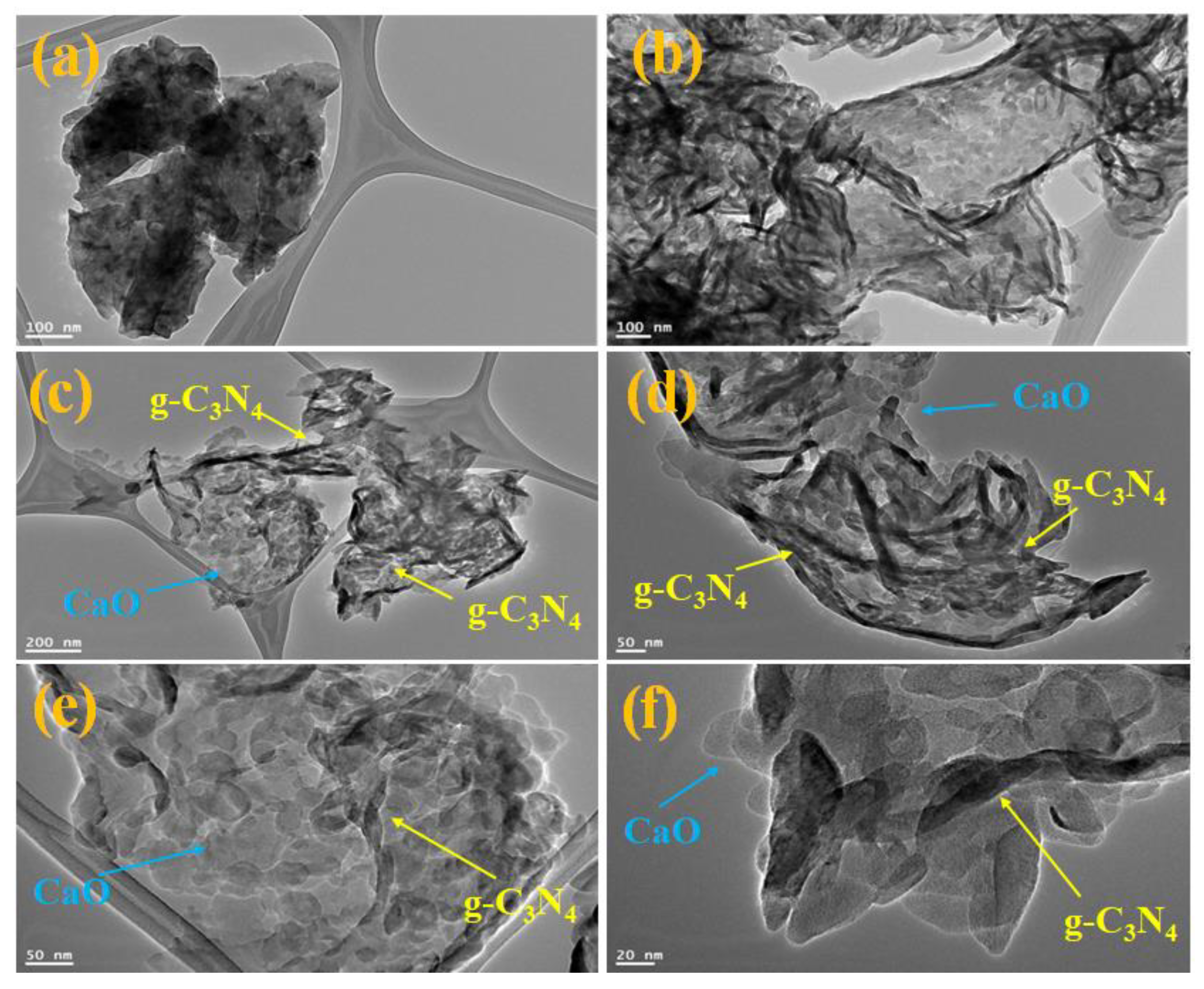
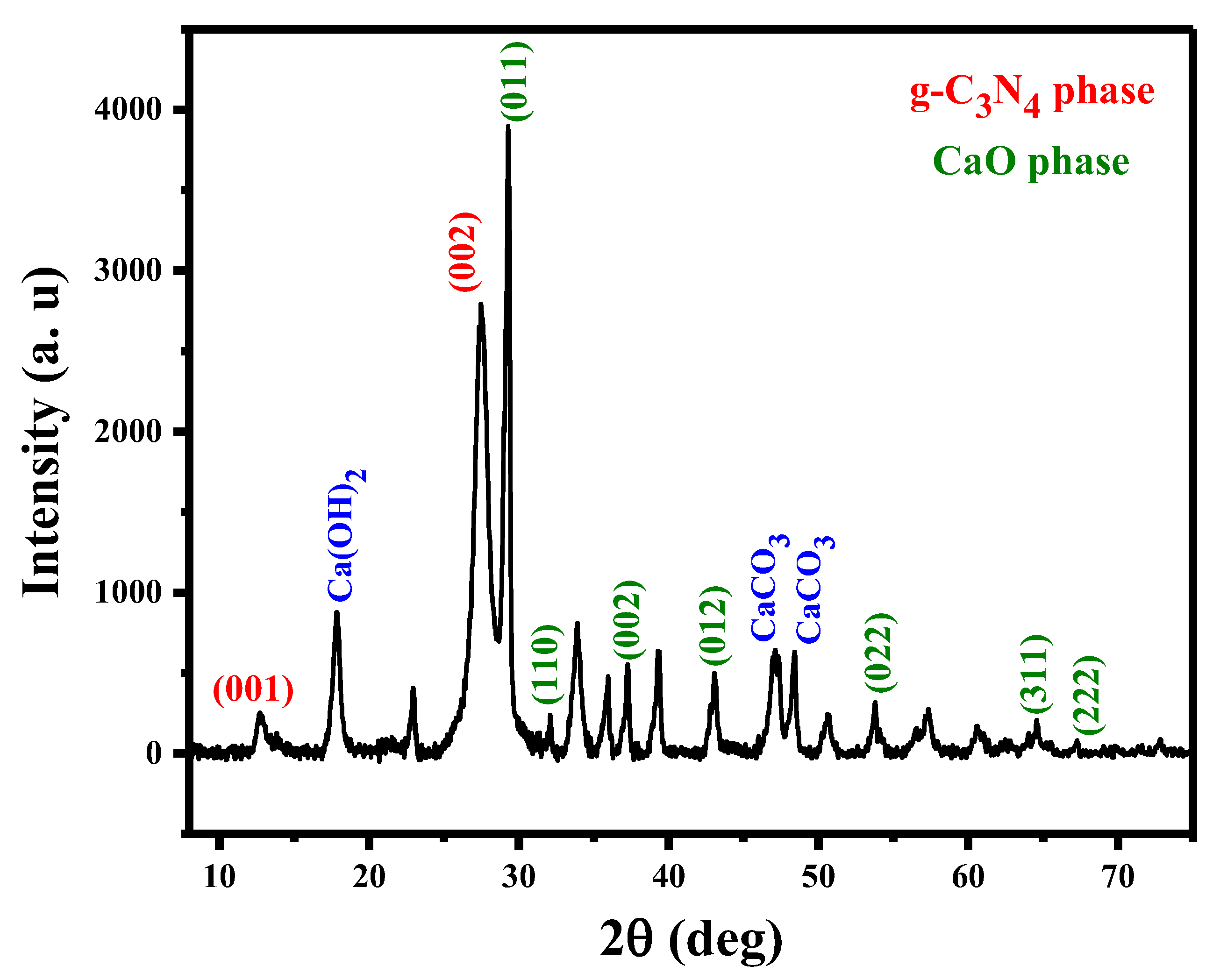
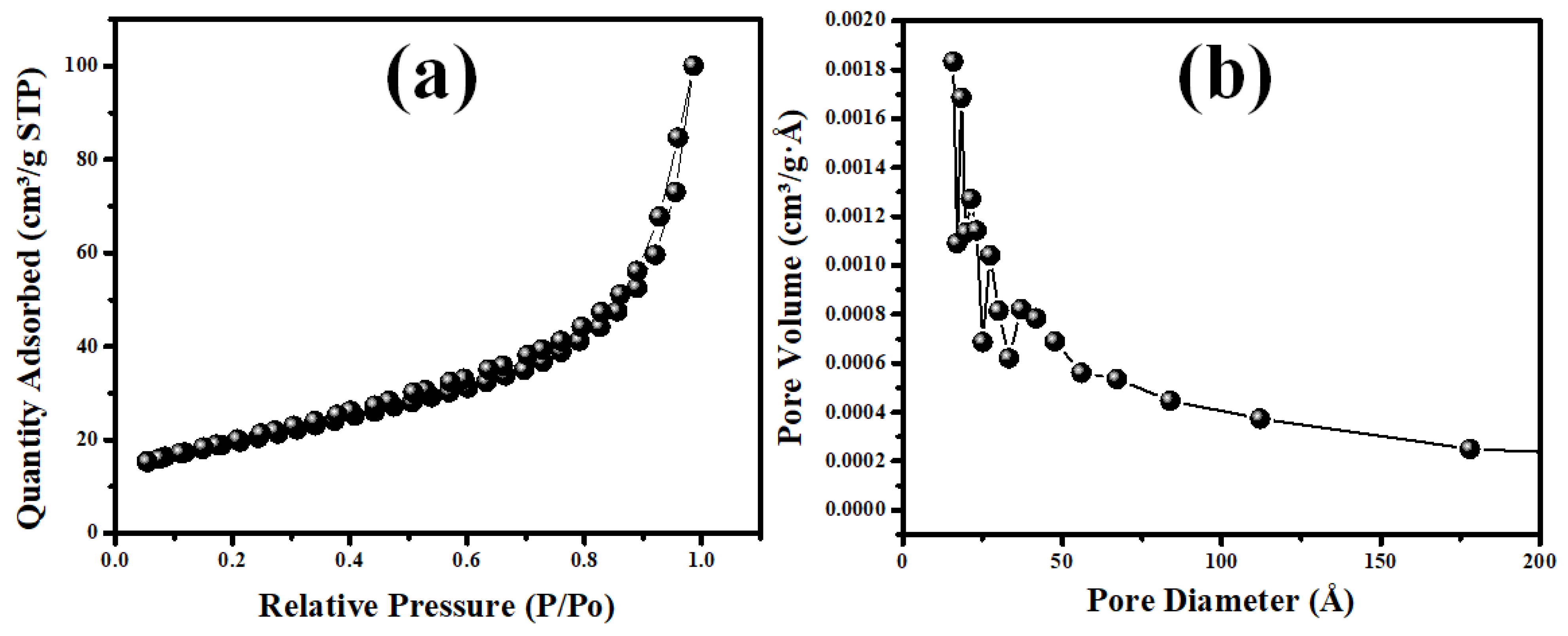
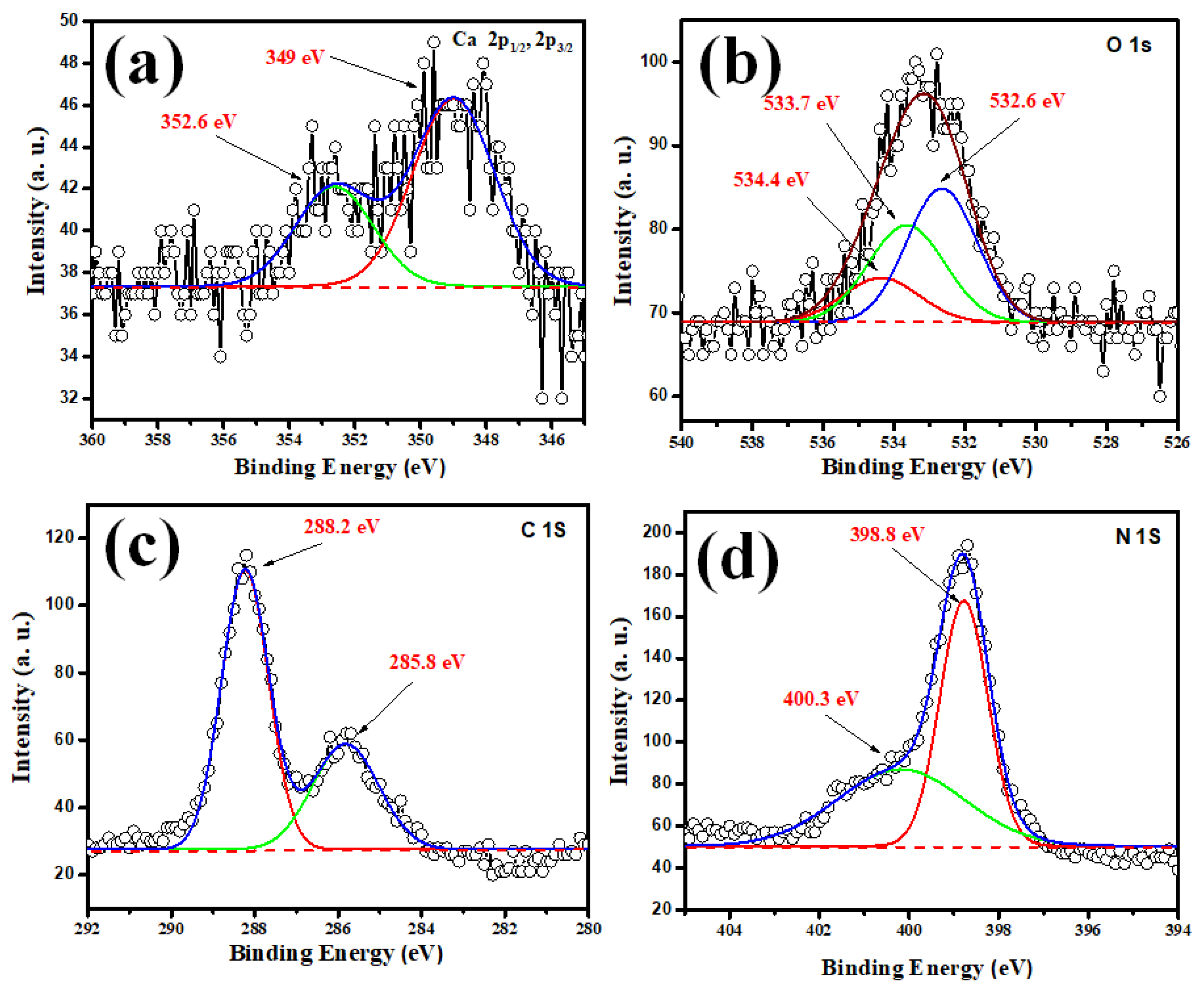
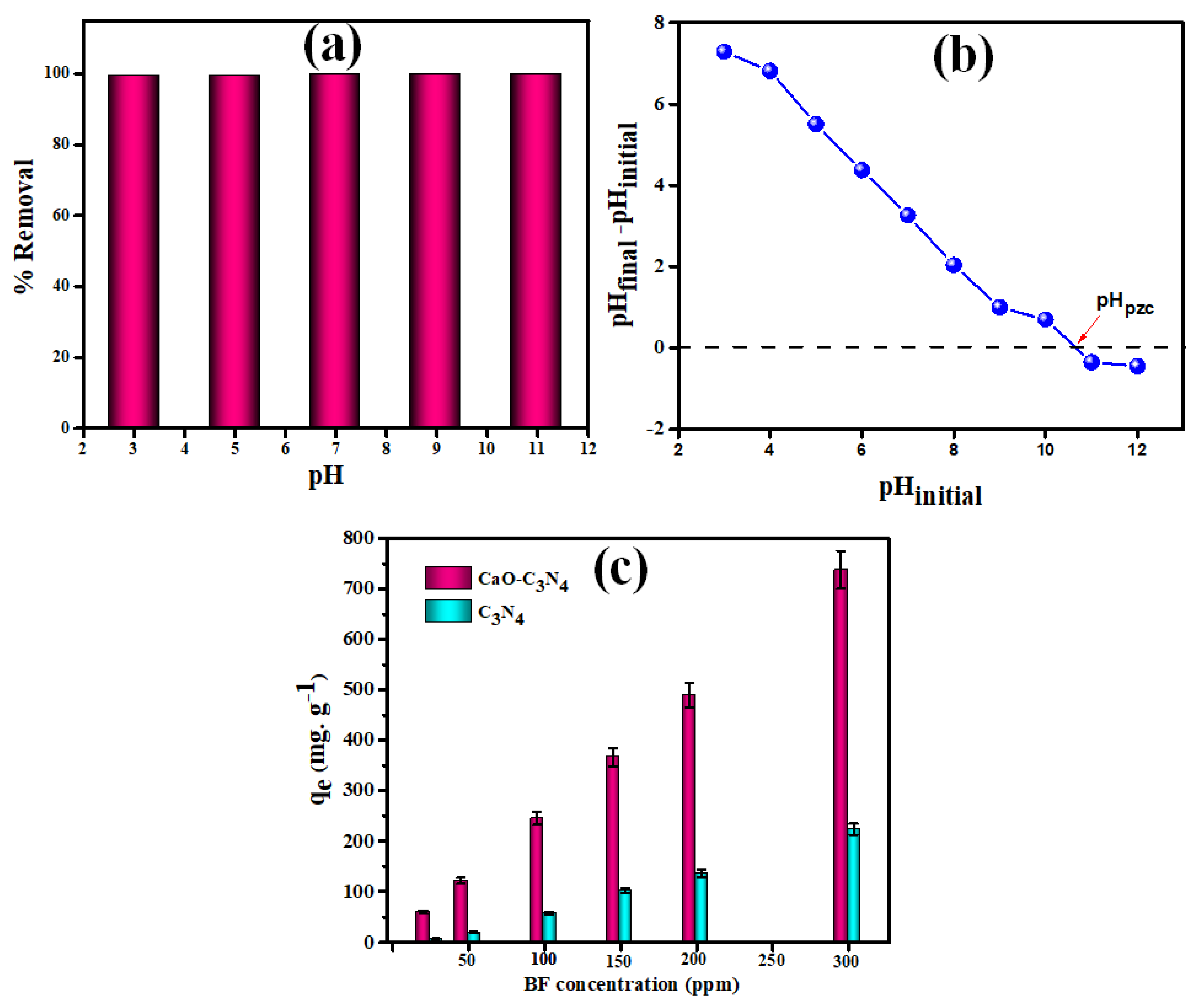
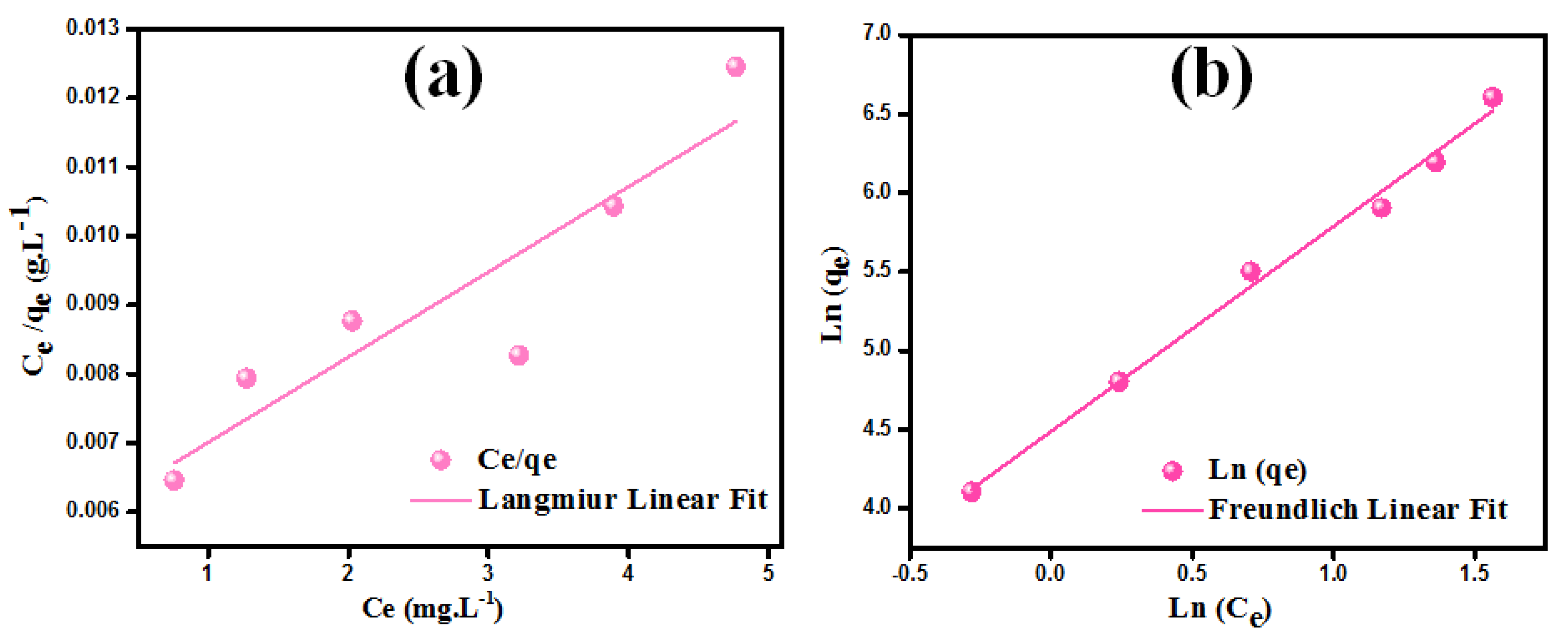
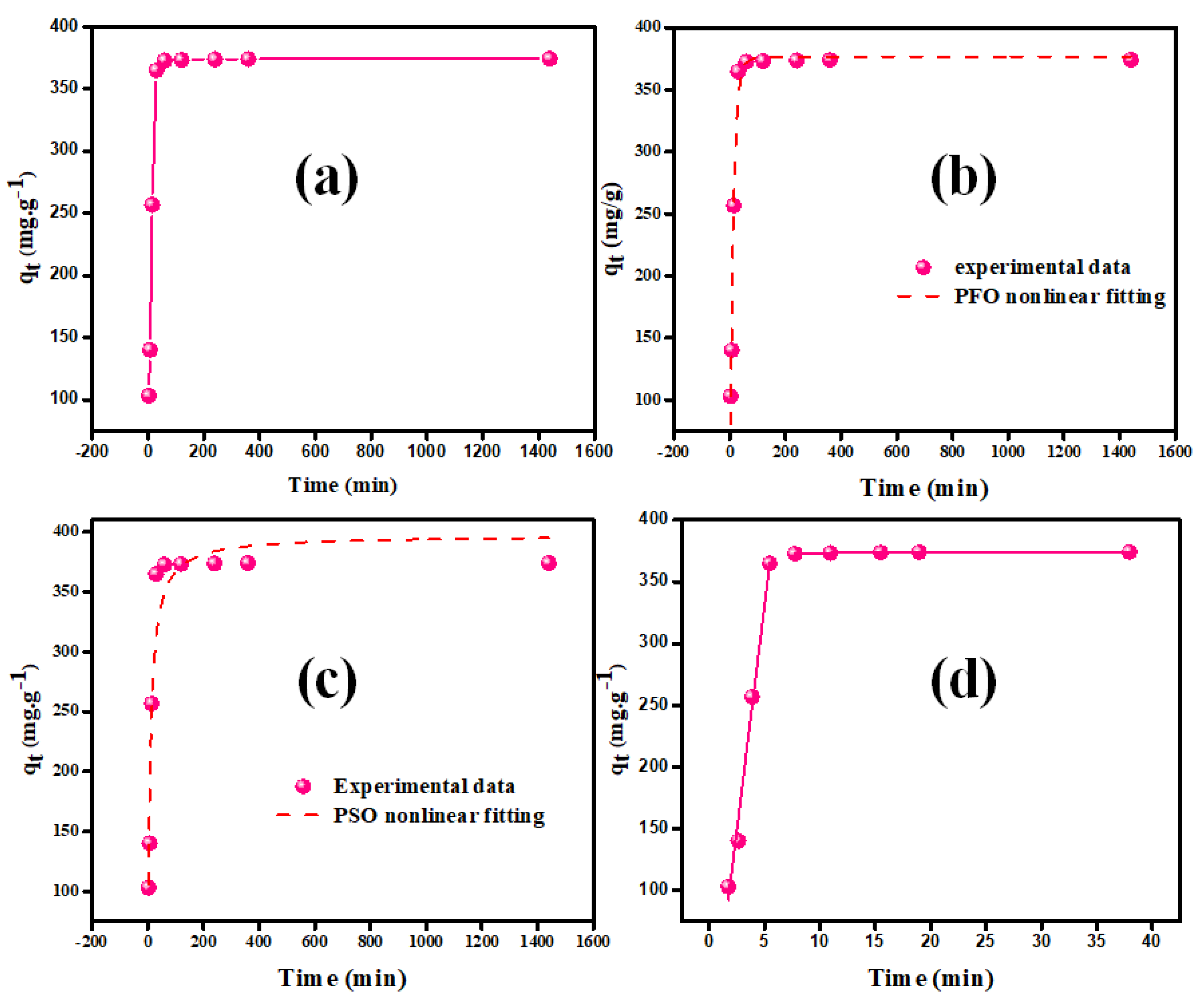


| Equilibrium Models | Linear Form | Parameter | Value |
|---|---|---|---|
| Langmuir [46] | qm (mg/g) | 813.0 | |
| KL (mg/g) | 0.212 | ||
| RL (L/mg) | 0.0015 | ||
| R2 | 0.842 | ||
| Freundlich [47] | n | 0.97 | |
| KF (L/mg) | 88.89 | ||
| R2 | 0.996 |
| Kinetics Models | Kinetic Equations | Parameter | Value |
|---|---|---|---|
| PFO [49] | Qm (exp) (mg/g) | 375.69 | |
| Qe (mg/g) | 376.49 | ||
| K1 (min−1) | 0.080 | ||
| R2 | 0.984 | ||
| PSO [49] | Qe (cal) (mg/g) | 397.13 | |
| K2 (g/mg·min) | 0.0003 | ||
| R2 | 0.930 | ||
| Intra-particle Diffusion [50] | Kdif1 (mg·min1/2/g) | 72.78 | |
| C1 | 33.53 | ||
| R2 | 0.987 | ||
| Kdif2 (mg. min1/2/g) | 0.04 | ||
| C2 | 372.83 | ||
| R2 | 0.643 |
| Adsorbents | qe (mg g−1) | Best pH | BET Surface Area (m2/g) | References |
|---|---|---|---|---|
| Fe-MgO/kaolinite | 10.36 | 9.0 | - | [55] |
| YZnO nanoparticles | 75.53 | 11 | 20.26 | [56] |
| Al/MCM-41 | 54.44 | 3–9 | 997 | [57] |
| Euryale ferox Salisbury seed shell | 19.48 | 6.0 | - | [58] |
| ESM | 47.85 | 6.0 | 11.56 | [59] |
| Fe/ZSM-5 | 251.87 | 5.0 | 399 | [60] |
| Modified activated carbons | 238.10 | 8.5 | 613 | [61] |
| MgO | 493.90 | 11 | 12.22 | [62] |
| MgOg-C3N4 | 1250 | 7.0 | 84.2 | [63] |
| CaO-g-C3N4 | 813.00 | Independent | 37.31 | Current study |
Disclaimer/Publisher’s Note: The statements, opinions and data contained in all publications are solely those of the individual author(s) and contributor(s) and not of MDPI and/or the editor(s). MDPI and/or the editor(s) disclaim responsibility for any injury to people or property resulting from any ideas, methods, instructions or products referred to in the content. |
© 2023 by the authors. Licensee MDPI, Basel, Switzerland. This article is an open access article distributed under the terms and conditions of the Creative Commons Attribution (CC BY) license (https://creativecommons.org/licenses/by/4.0/).
Share and Cite
Said, R.B.; Rahali, S.; Ben Aissa, M.A.; Albadri, A.; Modwi, A. Uptake of BF Dye from the Aqueous Phase by CaO-g-C3N4 Nanosorbent: Construction, Descriptions, and Recyclability. Inorganics 2023, 11, 44. https://doi.org/10.3390/inorganics11010044
Said RB, Rahali S, Ben Aissa MA, Albadri A, Modwi A. Uptake of BF Dye from the Aqueous Phase by CaO-g-C3N4 Nanosorbent: Construction, Descriptions, and Recyclability. Inorganics. 2023; 11(1):44. https://doi.org/10.3390/inorganics11010044
Chicago/Turabian StyleSaid, Ridha Ben, Seyfeddine Rahali, Mohamed Ali Ben Aissa, Abuzar Albadri, and Abueliz Modwi. 2023. "Uptake of BF Dye from the Aqueous Phase by CaO-g-C3N4 Nanosorbent: Construction, Descriptions, and Recyclability" Inorganics 11, no. 1: 44. https://doi.org/10.3390/inorganics11010044






